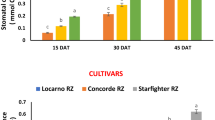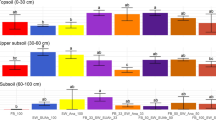Abstract
Culm characteristics of Melocanna baccifera, locally ‘muli’, culms at five different culm ages of 11 girth classes (5–6 to 15–16 cm) were studied from Cachar District of southern Assam, northeast India. We recorded internode length, internode diameter, number of internodes per culm, total culm height, total culm green weight and total culm volume of all five culm age classes. Data were gathered on 165 culms, each culm age class containing 33 culms with 3 culms per girth class. Culm height ranged from 3.2 to 15.3 m with highest mean of 9.15 m (in three-year old culms) and maximum culm height was recorded in four-year old culms. Highest mean and maximum internode length (27.45 and 54.2 cm, respectively), internode diameter (3.12 and 4.75 cm, respectively) and total culm green weight (5.42 and 12.87 kg/culm, respectively) were recorded in three-year old culms and lowest in current-year culms. Best fitted regression models for all parameters were developed. Significant linear relationships between culm green weight and culm solid volume were documented for all five culm age classes. Their corresponding best-fit regression models were also developed.




Similar content being viewed by others
References
Banik RL (2000) Silviculture and field-guide to priority bamboos of Bangladesh and South Asia. Government of the People’s Republic of Bangladesh, Bangladesh Forest Research Institute, Chittagong
Biswas S, Naithani HB, Chandra S (1991) Occurrence of Melocanna baccifera in Sikkim. Indian For 117:583–586
BPG (2012) An updated tribal and subtribal classification of the bamboos (Poaceae: Bambusoideae). J Am Bamboo Soc 24:1–10
Champion HG, Seth SK (1968) A revised survey of the forest types of India. Natraj Publishers, Dehradun (Reprinted 2005)
Chen TH, Chung HY, Wang DH, Lin SH (2009) Growth and biomass of makino bamboo in Shinmen reservoir watershed area. Q J Chin For 42:519–527 (in Chinese with English summary)
Correal JF, Arbelaez J (2010) Influence of age and height position on Colombian Guadua angustifolia bamboo mechanical properties. Maderas Ciencia Y Tecnol 12:105–113
Espiloy ZB (1987) Physico-mechanical properties and anatomical relationships of some Philippine bamboos. In: Rao AN et al. (eds.) Resent Research on Bamboo. Proceedings of an International Workshop. 14–16 October 1985, Hangzhou, pp 257–264
Espiloy ZB (1994) Effect of age on the physico-mechanical properties of some Philippine bamboo. In: FORSPA No. 6 IDRC/FAO/UNDP, pp 180–182
Guan M, Yong C, Wang L, Zhang Q (2012) Selected properties of bamboo scrimber flooring made of India Melocanna baccifera. Proceedings of the 55th International Convention of Society of Wood Science and Technology, Beijing, China
Hisham HN, Othman S, Rokiah H, Latif MA, Ani S, Tamizi MM (2006) Characterization of bamboo Gigantochloa scortechinii at different ages. J Trop For Sci 18:236–242
Inoue A, Sakamoto S, Suga H, Kitazato H, Sakuta K (2013) Construction of one-way volume table for the three major useful bamboos in Japan. J For Res 18:323–334
Krishnaswamy VS (1956) Bamboos- their silviculture and management. Indian For 82:308–313
Latif MA (2001) Anatomical features of Bambusa vulgaris and Gigantochloa scortechinii from four harvesting sites in Peninsular Malaysia. J Trop For Prod 7:10–28
Latif MA, Wan Tarmeze WA, Fauzidah A (1990) Anatomical features and mechanical properties of three Malaysian bamboos. J Trop For Sci 2:227–234
Mohamed AH, Wan Razali WM, Fauzidah A (1991) Characteristics and volume-weight relationship of four Malaysian bamboos. J Trop For Sci 4:87–93
Nandy S, Das AK, Das G (2004) Phenology and culm growth of Melocanna baccifera (Roxb.) Kurz in Barak Valley, North-East India. J Bamboo Rattan 3:27–34
Nath AJ, Das G, Das AK (2004) Phenology and culm growth of Bambusa cacharensis R. Majumdar in Barak Valley, Assam, North-East India. J Am Bamboo Soc 18:19–23
Nath AJ, Lal R, Das AK (2015a) Ethnopedology and soil quality of bamboo (Bambusa sp.) based agroforestry system. Sci Total Environ 521–522:372–379
Nath AJ, Lal R, Das AK (2015b) Managing woody bamboos for carbon farming and carbon trading. Glob Ecol Conserv 3:654–663
NCDPD (2010) Know your bamboo. Course material, 221 pp
Pattanaik S, PathakKC Bhuyan TC, Khobragade N, Das P, Prasad KG (2004) Mensurational studies in Melocanna baccifera. J Trop For Sci 16:62–70
Rao AN, Rao VR, Williams JT (1998) Priority species of bamboo and rattan. IPGRI-APO, Serdang
Roy N, Bezbaruah MP (2002) Agricultural growth and regional economic development. Mittal Publications, New Delhi
Sattar MA, Kabir MF, Bhattacharjee DK (1990) Effect of age and height position of Muli (Melocanna baccifera) and Borak (Bambusa balcooa) bamboo on their physical and mechanical properties. Bangladesh J For Sci 19:29–37
Sharma YML (1982) Some aspects of bamboos in Asia and the Pacific. RAPA No. 57. FAO. Bangkok
Shigematsu Y (1958) Analytical investigation of the stem form of important species of bamboo. Bull Faculty Agric 3:124–135
Tandug LM, Torres FG (1985) Mensurational attributes of five Philippine erect bamboos. In: Recent Research on Bamboos. Proceedings of the International Bamboo Workshop. October 6–14, 1985. Hangzhou, People’s Republic of China, pp 91–98
Watanabe M, Ueda K (1976) On the structure of Madake (Phyllostachys bambusoides). Rep Fuji Bamboo Garden 21:9–26
Watson L, Dallowitz MJ (1992) The grass genera of the world. CABI International, Wallingford, pp 591–592
Wong KM (1982) Malaysian bamboos in use. Nat Malays 7:34–39
Yen TM (2015) Comparing aboveground structure and aboveground carbon storage of an age series of moso bamboo forests subjected to different management strategies. J For Res 20:1–8
Yen TM, Lee JS (2011) Comparing aboveground carbon sequestration between moso bamboo (Phyllostachys heterocycla) and China fir (Cunninghamia lanceolata) forests based on the allometric model. For Ecol Manag 261:995–1002
Acknowledgments
Senior author is grateful to Mohan, Appu and Mukta for their help during the field study. Financial assistance from University Grants Commission, New Delhi is acknowledged. We thank two anonymous reviewers for their comments to improve the manuscript.
Author information
Authors and Affiliations
Corresponding author
Additional information
Project funding: This study was financially supported by University Grants Commission, New Delhi.
The online version is available at http://www.springerlink.com
Corresponding editor: Hu Yanbo
Rights and permissions
About this article
Cite this article
Singnar, P., Nath, A.J. & Das, A.K. Culm characteristics and volume-weight relationship of a forest bamboo (Melocanna baccifera (Roxb.) Kurz) from northeast India. J. For. Res. 26, 841–849 (2015). https://doi.org/10.1007/s11676-015-0099-8
Received:
Accepted:
Published:
Issue Date:
DOI: https://doi.org/10.1007/s11676-015-0099-8




